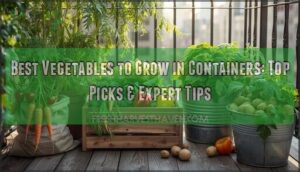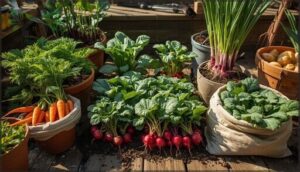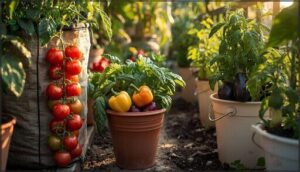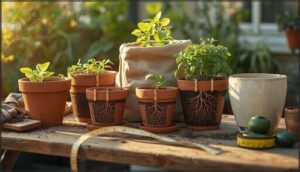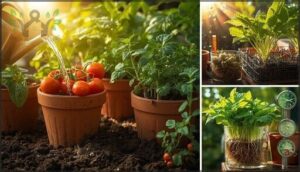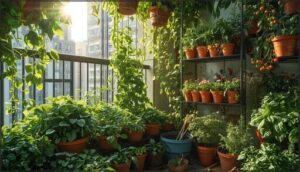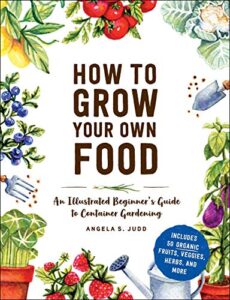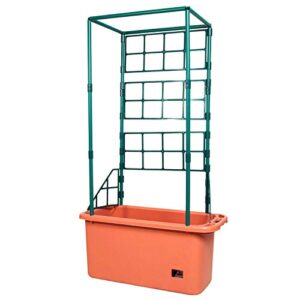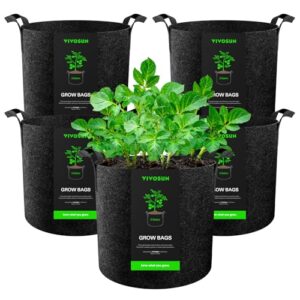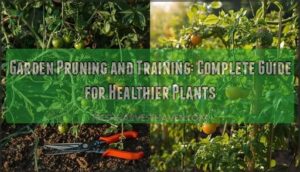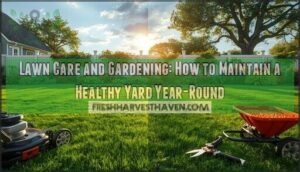This site is supported by our readers. We may earn a commission, at no cost to you, if you purchase through links.
You don’t need sprawling garden beds to grow your own food. A single 5-gallon bucket on a sunny balcony can yield 20 pounds of potatoes. A cluster of fabric grow bags can transform a drab patio into a tomato-producing powerhouse. Container gardening breaks the chains of traditional agriculture—no yard required, no tilling necessary, no waiting for perfect conditions.
The best vegetables to grow in containers thrive in confined spaces because their root systems adapt, their yields stay strong, and their care requirements stay manageable. Carrots, peppers, lettuce, and radishes don’t ask for much: the right depth, decent soil, and consistent attention.
Match your container size to your vegetable’s needs, choose materials that support root health, and you’ll harvest fresh produce all season long.
Table Of Contents
- Key Takeaways
- Top Vegetables to Grow in Containers
- Choosing The Right Container Size
- Essential Growing Conditions for Containers
- Tips for Maximizing Container Harvests
- Top Products for Container Vegetable Gardening
- Frequently Asked Questions (FAQs)
- What vegetable is best to grow in pots?
- What is the easiest vegetable to grow in pots?
- What are the best low maintenance plants in pots?
- What is the most common mistake made with container plants?
- What vegetables can be grown in pots?
- What can you grow in a container garden?
- Can you grow vegetables in containers?
- What are the best container vegetables to grow easily?
- What vegetables grow well in pots & window boxes?
- What plants can you grow in pots?
- Conclusion
Key Takeaways
- You can grow high-yielding vegetables like tomatoes, peppers, carrots, and potatoes in containers as small as 5 gallons, making productive food gardening possible on balconies, patios, or any sunny spot without traditional garden beds.
- Matching container depth to root systems is critical—shallow crops like lettuce need only 6-8 inches while deep-rooted vegetables like potatoes require 16-24 inches, and using breathable fabric grow bags instead of plastic improves root health by up to 30%.
- Container vegetables demand daily watering during summer heat and fertilizing every 2-4 weeks because nutrients leach out faster than ground soil, but strategic techniques like vertical trellising, succession planting, and companion planting can boost total yields by 30-70%.
- The right setup matters more than space—fabric grow bags with proper drainage, quality soilless potting mix with compost, and 6-8 hours of direct sunlight create conditions where container gardens consistently outperform traditional in-ground beds.
Top Vegetables to Grow in Containers
You don’t need sprawling garden beds to grow your own food. Containers give you the freedom to grow vegetables anywhere—on balconies, patios, or even fire escapes.
Here are the top picks that thrive in pots and deliver serious harvests.
Root Vegetables for Pots (Carrots, Beets, Radishes, Onions, Turnips, Potatoes)
Root crop selection starts with matching container depth to each vegetable’s needs. Carrots demand 6 to 15 inches, while radishes thrive in just 2 to 6 inches. Beets need 4 to 12 inches, onions require 6 to 8 inches, and potatoes excel in 16-inch-deep containers.
Proper vegetable spacing—2 to 4 inches for carrots and beets—ensures solid harvest timing. Loose soil preparation prevents stunted roots. For ideal growth, consider using a slow release fertilizer to promote healthy plant development.
Nightshades and Fruit-Bearing Vegetables (Tomatoes, Peppers, Eggplant, Okra)
Nightshades break free from ground constraints with explosive container yields. Tomatoes in 7-gallon bags deliver nearly 30 pounds per plant—crushing in-ground results. Peppers resist disease better in isolated pots, while eggplant thrives in 12-16 inch containers using self-watering systems. Okra demands 5-gallon minimums and blazing sun.
Nightshades in containers—tomatoes, peppers, eggplant, okra—break free from ground limits and deliver explosive yields in isolated pots
Rotate nightshade soil every 3-6 years to dodge pests and keep your rebellion thriving.
To boost yields, consider implementing soil fertility methods in your container gardening practice.
Choosing The Right Container Size
Your container choice matters more than you think—go too small and your vegetables will struggle, go too big and you’re wasting soil and space. The right size depends on what you’re growing and how deep its roots need to go.
Let’s break down the exact container dimensions your vegetables need to thrive.
Minimum Container Size Guidelines by Vegetable
You can’t just toss seeds into any old pot and expect miracles. Container depth matters for root growth—tomatoes need 12 inches minimum, carrots demand double their expected length, while radishes thrive in shallow 6-inch spaces.
Soil volume directly impacts crop yield: peppers want 5-10 gallons, potatoes need 15 inches deep. Match container size to your plant’s root system, and you’ll achieve serious harvests in tight spaces.
Best Container Materials for Healthy Growth
After nailing container size, material durability becomes your next battlefield for root health and water efficiency.
Plastic containers retain moisture but may leach chemicals—polyethylene can stunt roots at high concentrations. Terra cotta breathes beautifully yet demands 30% more watering. Fabric grow bags air-prune roots, boosting mass by 30%, while metal heats soil dangerously fast.
Choose wisely for soil quality and container garden maintenance success.
Matching Container Depth to Root Systems
Beyond material selection, your container depth analysis separates thriving crops from stunted failures. Shallow-rooted lettuce and radishes flourish in 6 to 8 inches, while peppers demand 12 to 18 inches for soil volume management. Deep-rooted carrots and potatoes need 24 inches minimum—anything less stunts tuber development.
Container size optimization for vegetable root systems drives plant health monitoring success in small space vegetable gardening.
Essential Growing Conditions for Containers
Getting the container size right is only half the battle—your vegetables won’t thrive without proper light, soil, and water.
These three elements work together to create the conditions your plants need to produce a solid harvest. Let’s break down exactly what your container vegetables require to grow strong and deliver results.
Sunlight Requirements for Container Vegetables
Light is the fuel your container vegetables run on—without enough daily exposure, even the best setup will underperform. Most fruiting crops demand 6–8 sunlight hours for strong yields, while leafy greens and root vegetables tolerate partial shade with 4–6 hours.
Here’s what drives photosynthesis rates and harvest success:
- Fruiting crops (tomatoes, peppers, eggplant) need 8 hours minimum for peak production
- Root vegetables (carrots, beets, turnips) thrive with 6 hours of direct light
- Leafy greens (lettuce, spinach, kale) grow well in 4–6 hours, showing strong shade tolerance
- Light intensity directly influences chlorophyll content and final harvest weight
Track your space’s sun patterns before placing containers—southern exposures deliver the most consistent light for container gardening success.
Soil and Compost Mixes for Pots
Soil composition makes or breaks your container gardening setup—skip traditional garden soil and reach for soilless potting mixes instead. Blend 2 parts peat moss with 1 part perlite for ideal drainage, then add 25–33% high-quality compost for nutrient density.
Organic container gardening tips recommend pH levels between 6.2–6.8 for most vegetables. Balance your fertilizer types with a 4:1:4 N:P:K ratio, and refresh mixes yearly to dominate small space gardening challenges.
Watering and Fertilizing Best Practices
Your containers demand daily watering in summer heat—check soil moisture each morning and drench until water drains freely. Mix slow-release fertilizer at planting, then feed every 2–4 weeks with soluble options to counter rapid nutrient depletion.
Organic container gardening preserves vitamin C levels while synthetic types boost yield. Master irrigation scheduling and fertilizer types to realize true container gardening potential with these essential vegetable gardening tips and tricks.
Tips for Maximizing Container Harvests
Growing vegetables in containers isn’t just about choosing the right pot and soil—it’s about working smarter to squeeze more harvest from every square inch. You can transform a modest balcony into a productive mini-farm by stacking growing methods and timing your plantings strategically.
Here are the key techniques that’ll help you grow more food in less space.
Vertical Gardening and Trellis Use
When you’re growing vegetables in containers, vertical gardening transforms your space from cramped to productive. Trellis systems and vertical aids can boost crop yield by 30% while cutting disease issues by 40%.
Here’s how to optimize garden productivity in pots:
- Train vining crops upward – Cucumbers, peas, and tomatoes thrive on trellises
- Stack towers for space efficiency – Grow 50 plants per square foot
- Improve air circulation – Reduce fungal problems markedly
- Harvest earlier – Vertical aids speed maturity by one week
Succession Planting for Continuous Crops
You can harvest fresh vegetables every single week when you plant fast-growing crops at timed intervals. For container gardening, sow lettuce, radishes, or carrots every 2-3 weeks—this keeps your harvest scheduling steady.
Crop rotation between cycles maintains soil health, while proper water management ensures seedlings and mature plants both thrive.
Select vegetable seeds suited for containers, and you’ll enjoy continuous crops all season.
Companion Planting in Containers
Pairing the right plants in your pots breaks all the rules—in a good way. Strategic companion planting in containers delivers measurable pest control and nutrient cycling wins.
Consider these proven combos for your vegetable garden:
- Tomatoes with basil boost yields by 10-12% while repelling thrips
- Strawberries and thyme cut pest activity markedly
- Marigolds with any container vegetables repel whiteflies and aphids
Polyculture benefits include 32% higher total harvests and stronger soil health than single-crop pots.
Space-Saving and Productivity Strategies
Beyond smart plant pairings, reconfiguring your setup unlocks bigger harvests. Movable containers let you chase sunlight, boosting yields 28% over fixed beds. Tiered arrangements expand productive area by up to 50% without claiming extra ground. Pair that with vertical farming using trellises, and you’ll squeeze 70% more from every square foot.
| Strategy | Yield Boost |
|---|---|
| Container mobility | 28% |
| Tiered layouts | 32–50% |
| Vertical gardening | Up to 70% |
| Succession planting | 30–50% |
Crop rotation in modular setups prevents nutrient depletion and drives 22% better productivity year-over-year. Soil optimization with quality compost pushes output another 18–24%. These small-space gardening solutions transform tight patios into prolific food factories.
Top Products for Container Vegetable Gardening
You don’t need fancy equipment to grow great vegetables in containers. The right tools just make it easier to start strong and keep your plants thriving.
Here are five products that deliver real results for container gardeners at any level.
1. Container Gardening For Beginners Guide
You want freedom from guesswork? This 144-page guidebook breaks down container gardening for beginners with profiles of 50+ easy-to-grow crops, each with specific container basics, soil preparation, and watering advice.
It addresses common beginner mistakes head-on—like using dense garden soil or undersized pots—and delivers practical urban gardening solutions for small spaces.
Published by Adams Media at $16.29, it’s your no-nonsense manual for container vegetables, covering everything from gardening tools to harvesting tips. Start small, learn fast, and take control of your harvest.
Best For: Beginners with limited space—like apartment dwellers or urban gardeners—who want a straightforward, illustrated guide to start growing vegetables, herbs, and fruits in containers without overwhelming technical details.
- Covers 50 beginner-friendly crops with specific container sizes, soil tips, and care instructions so you’re not left guessing what works.
- Tackles the most common mistakes upfront—poor soil choices, wrong container sizes, drainage issues—helping you avoid the failures that trip up 65% of new gardeners.
- Compact at 144 pages and priced at $16.29, it’s accessible and practical for anyone testing the waters of container gardening without a huge commitment.
- Some readers find it overpriced for the content depth, especially if you’re looking for advanced techniques or regional advice beyond popular crops.
- The focus leans toward common vegetables and herbs, so if you want specialized or unusual plants, you might need to look elsewhere.
- Illustrations and layout may feel too basic for experienced gardeners or those who prefer dense, technical resources over beginner-friendly visuals.
2. Heavy Duty Grow Bags Set
Heavy duty grow bags flip the script on traditional plastic pots. Made from 300g polyester felt fabric, these breathable bags deliver enhanced soil aeration and root health through air-pruning, preventing roots from strangling themselves.
You get 10-gallon bag size options with double-stitched grips that hold full soil weight. They’re reusable for 7-8 seasons, fold flat for storage, and work brilliantly for container vegetables in tight spaces.
The fabric durability assists everything from tomatoes to carrots while draining excess water automatically—exactly what vegetable gardening for small spaces demands.
Best For: Urban gardeners and small-space growers who need portable, reusable containers that promote healthier root systems and prevent overwatering.
- Superior aeration and drainage through breathable fabric prevents root rot and promotes air-pruning for healthier, more fibrous roots
- Durable construction with reinforced handles and 7-8 season lifespan makes them a cost-effective, eco-friendly alternative to disposable plastic pots
- Lightweight and foldable design allows easy repositioning for optimal sunlight and compact off-season storage
- 2-3 season lifespan reported by some users falls short of the advertised 7-8 seasons, depending on care and usage intensity
- Fabric material may not support very large or heavy plants as securely as rigid containers
- Some customers have reported inconsistent product quality or negative experiences with certain sellers
3. Indoor Tomato Growing System Tower
Indoor vertical systems break you free from seasonal limits and space constraints. A tower design holding 12-15 tomato plants per unit maximizes your growing footprint, while automated watering manages nutrient delivery.
You’ll need supplemental indoor lighting for 12-16 hours daily and manual pollination with a small fan. Compact, indeterminate tomato varieties thrive in these setups, producing fruit year-round with proper vertical support.
Container gardening indoors delivers continuous harvests—up to eight cycles annually—turning any room into productive vegetable gardening territory for dedicated tomato plants.
Best For: Urban growers and apartment gardeners who want year-round tomato harvests without outdoor space, and are willing to manage lighting and pollination indoors.
- Fits 12-15 plants in a compact vertical footprint, making it perfect for maximizing limited indoor space while producing continuous harvests up to eight cycles per year.
- Automated watering and nutrient delivery take the guesswork out of feeding your plants, reducing the risk of over- or underwatering common in container setups.
- Aeroponic or hydroponic systems use up to 90% less water than traditional soil gardens and virtually eliminate soil-borne pests and diseases.
- Requires daily supplemental grow lights for 12-16 hours, which increases electricity costs and demands consistent monitoring of light schedules.
- Manual pollination with fans or hand vibration is necessary indoors since natural pollinators aren’t present, adding extra maintenance steps.
- Initial setup costs are higher than basic containers, and the system needs proper trellising or external support to handle the weight of mature fruiting plants.
4. Heavy Duty Grow Plant Bags
These 20-gallon bags stand out with their thick-walled nonwoven fabric and BPA-free construction, ensuring durability for 3–5 years under regular use. They feature reinforced grips and built-in drainage, making them ideal for heavy loads of tomatoes, peppers, and deep-root vegetables in patio and balcony gardening setups.
Container durability is crucial when the combined weight of soil and harvest reaches 40 kilograms. Proper aeration in these bags reduces the risk of root rot by 15%, allowing your container vegetables to thrive in environments where ground planting is not feasible.
Gardening innovations, such as weather-resistant polymers, ensure these bags are reusable across multiple seasons, maximizing the efficiency of your container garden design without the need for breaking ground.
Best For: Urban gardeners and balcony growers who need durable, portable containers for deep-root vegetables like tomatoes and potatoes without permanent ground planting.
- Heavy-duty 300g nonwoven fabric lasts 3–5 years with proper care, making them a solid investment for multiple growing seasons.
- Built-in drainage and aeration reduce root rot risk by 15%, keeping plants healthier than traditional plastic pots.
- Reinforced handles support up to 40 kg, so you can move fully loaded bags around patios and decks without strain.
- Dry out faster than plastic pots, especially on hot days, so you’ll need to water more often and keep an eye on moisture levels.
- Handles aren’t always strong enough for the heaviest loads, so lifting soil-filled bags requires some caution.
- Actual capacity can run smaller than the advertised 20 gallons, which might be tight for larger plants or multiple crops in one bag.
5. Heavy Duty Garden Grow Bags
You’ll notice a shift in grow bag materials, with nonwoven polypropylene and felt blends lasting 3–5 and 5–7 seasons respectively, while biodegradable options made from jute or coconut coir break down naturally within 6–8 months.
Garden bag sizes matter—15-gallon bags balance portability with productivity, while 20-gallon versions boost yields for container vegetables in patio and balcony gardening.
Heavy-duty fabrics with UV resistance extend longevity, and smart gardening systems now integrate sensors for automated watering, transforming small-space gardening ideas into efficient, high-yield operations.
Best For: Urban gardeners and small-space growers who need portable, breathable containers for vegetables, herbs, and flowers without committing to permanent garden beds.
- Promotes healthier root systems through superior aeration and drainage, preventing root circling and supporting stronger plant growth across multiple seasons.
- Affordable entry point at $14.99 for five 3-gallon bags, with durable nonwoven fabric lasting 3–5 seasons when stored properly between uses.
- Lightweight and portable design with reinforced handles makes it easy to rearrange your garden layout, chase sunlight, or bring plants indoors during harsh weather.
- Dries out faster than traditional pots, especially on hot days, requiring more frequent watering and consistent soil moisture monitoring.
- Handles aren’t built for heavy lifting once bags are filled with wet soil—a 3-gallon bag can weigh 25–30 pounds when fully saturated.
- May develop staining or lichen growth over time with outdoor exposure, and won’t provide enough stability for tall, top-heavy plants like indeterminate tomatoes without additional support.
Frequently Asked Questions (FAQs)
What vegetable is best to grow in pots?
Radishes thrive in pots because they mature in three weeks and tolerate cramped quarters.
Lettuce follows closely—shallow roots make it ideal for container gardening, delivering fresh greens without demanding deep soil or complex watering tips.
What is the easiest vegetable to grow in pots?
Lettuce takes the crown for container gardening newbies. You’ll harvest fresh greens in just 30 days with minimal fuss.
Its shallow roots need only six inches of depth, making success nearly foolproof.
What are the best low maintenance plants in pots?
The laziest plants demand the most attention—until you discover ZZ plants, snake plants, and pothos.
These drought-tolerant species thrive on neglect, needing water every two weeks while transforming your container gardening into easy harvests.
What is the most common mistake made with container plants?
The biggest trap you’ll fall into? Overwatering. It triggers poor drainage, root suffocation, and waterlogged soil—leading to nutrient deficiency.
Container gardening demands restraint. Let soil breathe between waterings for thriving container gardening vegetables.
What vegetables can be grown in pots?
You can plant a whole harvest in pots—think cherry tomatoes, leafy greens like spinach and arugula, root vegetables such as carrots and beets, plus peppers and beans.
Container gardening vegetables reveal small space urban farming possibilities.
What can you grow in a container garden?
You can grow herbs, leafy greens like spinach and arugula, tomatoes, peppers, cucumbers, root vegetables including carrots and radishes, and even compact fruiting crops—basically transforming balcony gardening or urban farming spaces into productive harvests.
Can you grow vegetables in containers?
Think of container gardening as your passport to urban farming freedom. You can absolutely grow vegetables in containers—it’s perfect for small space gardening, letting you overcome soil challenges while maximizing benefits of container gardening.
What are the best container vegetables to grow easily?
Lettuce, radishes, and cherry tomatoes top the easy-grow list for containers. They mature fast, tolerate beginner mistakes, and deliver impressive yields—lettuce produces five to nine harvests yearly in small pots.
What vegetables grow well in pots & window boxes?
Cherry tomatoes, peppers, and leafy greens like spinach and kale thrive in pots and window boxes. Carrots and radishes work well too. Choose compact varieties for best results.
What plants can you grow in pots?
You can cultivate dozens of edibles in pots—from fast-maturing radishes and leafy greens to tomatoes and peppers.
Container gardening unlocks urban gardening freedom, turning patios into productive harvests with smart herb selection and microgreens care.
Conclusion
You picked up this guide at exactly the right moment—right before planting season, right when container space matters most. The best vegetables to grow in containers don’t demand flawlessness. They demand action.
Choose your crops, match them to the right pots, and start growing. Your balcony holds more potential than you think.
Every harvest proves you don’t need land to claim independence—just soil, sun, and commitment.
- https://blogs.oregonstate.edu/gardenecologylab/2021/08/27/tylers-research-on-containerized-vegetable-gardens/
- https://growinginthegarden.com/20-best-vegetables-for-container-gardening/
- https://rsisinternational.org/journals/ijriss/articles/comparative-production-of-selected-high-value-crops-adopting-container-gardening/
- https://extension.unh.edu/resource/growing-vegetables-containers-fact-sheet
- https://www.statista.com/statistics/716558/us-container-gardening-participation/

